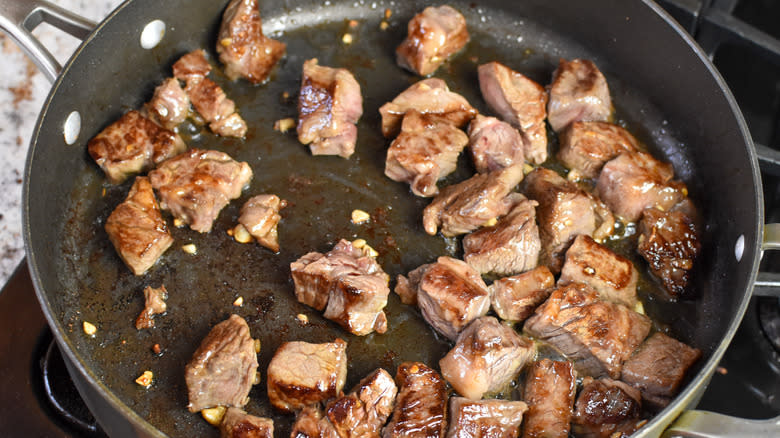Vietnamese Shaking Beef Might Be The Most Perfectly Named Dish

Vietnamese foods delight diners with their use of aromatic spices, bright herbs, and juxtaposition of textures. The cuisine reaches for accessible ingredients and transforms them in imaginative ways. One such meat dish is the popular Vietnamese shaking beef.
Known in Vietnamese as bò lúc lắc, the dish vigorously stir-fries chunks of meat -- such as ribeye, sirloin, or flank steak -- alongside an aromatic sauce. The resultant bites, which are perfectly pink on the inside, are served on a bed of watercress, cilantro, onions, and tomatoes with a squeeze of lime. The savory and slightly sweet chunks of beef perfectly contrast with the bright and herbal vegetation. Almost like a salad meets stir-fry, the dish shines when prepared fresh. While its ingredients can shift, with some renditions altering the vegetables and beef cuts and others serving a lime-based dipping sauce alongside for extra tang, one characteristic remains consistent -- the cooking technique. As per its name, the dish involves a pan-shaking maneuver, which defines the scrumptious result. Tasting Table recipe developer, Stephanie Rapone, who came up with our Vietnamese shaking beef recipe, describes the method like this: "It's a Vietnamese stir-fry where you have to stir and shake the beef to get an even sear." Let's dive into the details.
Read more: Your Guide To The Different Cuts Of Steak
Vietnamese Shaking Beef Is All About Agitating The Pan

Like many other culinary creations in Vietnam -- such as a baguette-based banh mi -- French cuisine imparted an influence onto bò lúc lắc. The European colonial period initiated the consumption of beef in the Asian nation, hence the use of steak. Plus, some versions involve tomato paste, another French-born ingredient. Meanwhile, the mixture of oyster and soy sauce in the marinade comes by way of China, as does the technique of stir-frying with a wok.
A riff on this form of fiery, high-heat cooking is precisely what defines bò lúc lắc. Its central methodology is reflected in the name: Bò translates to cow, and lúc lắc is an onomatopoeia referencing the sound of meat hitting a pan. Basically, the meat is constantly moving and sizzling in the pan as it is shaken while it is fast-cooked. The intensive movement uniformly cooks the chunks of beef while simultaneously coating the protein in a pungent sauce. The high heat deglazes the pan, thickening the aromatic glaze. Combined with a bundle of fresh watercress and aromatic cilantro, the tasty caramelized notes perfectly juxtapose with a bright herbal burst. This means all that vigorous shaking comes together into a delectable result that's more than worth the arm-tiring effort.
Read the original article on Tasting Table.


